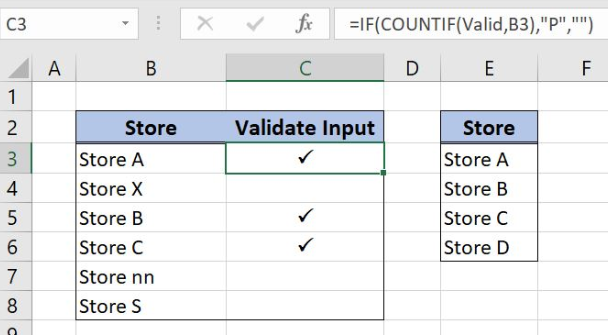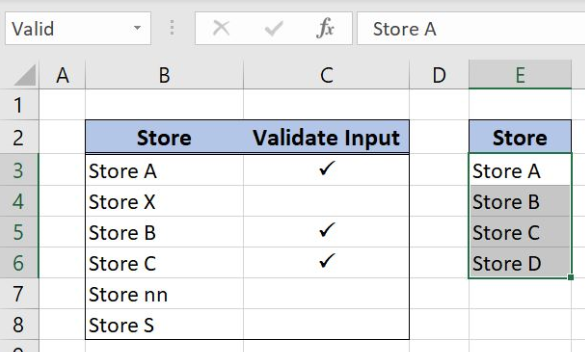Excel allows a user to validate input with check mark using IF and COUNTIF function. This step by step tutorial will assist all levels of Excel users in validating the inputs with check marks based on the data from another table.
 Figure 1. Validate store input with the check mark
Figure 1. Validate store input with the check mark
Syntax of the IF Formula
The generic formula for the IF function is:
=IF(logical_test, value_if_true, value_if_false)
The parameters of the IF function are:
- logical_test – a logical expression that we want to check
- value_if_true – a value which the function returns if a logical_test is TRUE
- value_if_false – a value which the function returns if a logical_test is FALSE.
Syntax of the COUNTIF Formula
The generic formula for the COUNTIF function is:
=COUNTIF(range, criteria)
The parameters of the COUNTIF function are:
- range – range where we want to apply our criteria
- criteria – a criteria in criteria range which we want to count.
Setting up Our Data to Validate Store Input with Check Mark
 Figure 2. Data that we will use in the example
Figure 2. Data that we will use in the example
Our first table consists of 2 columns: “Store” (column B) and “Validate Input” (column C) while the second one has one column “Store” (column E). The idea is to label the stores from column B that are matchable with the stores from the second table and to put the check mark in column C.
Validate Stores with Check Mark Using IF and COUNTIF Functions
In our example, we want to check and mark the stores from the first table that exist in the second table using IF and COUNTIF functions. In order to make the formula more clear we will create a named range Valid for the cell range E3:E6.
To create a named range we should follow the steps:
- Select the cell range that should be named
- Click on the name box in Excel
- Write the name for the cell range and press enter
 Figure 3. Creating a named range Valid for the inputs validation
Figure 3. Creating a named range Valid for the inputs validation
The formula looks like:
=IF(COUNTIF(Valid,B3),"P","")
The logical_test in the IF function is the formula COUNTIF(Valid,B3). The parameter value_if_true is the string “P” while the value_if_false is an empty string. In the COUNTIF function range is a named range Valid while the criteria is the cell B3.
To apply the function, we need to follow these steps:
- Select cell C3 and click on it
- Insert the formula:
=IF(COUNTIF(Valid,B3),"P","") - Press enter
- Drag the formula down to the other cells in the column by clicking and dragging the little “+” icon at the bottom-right of the cell
- Change a Font in column C to Wingdings 2 to display check marks
 Figure 4. Validate store inputs using IF and COUNTIF functions
Figure 4. Validate store inputs using IF and COUNTIF functions
COUNTIF function is checking if a store from column B exists in the column E. Result will be a number 1 if there is a store in column E and 0 if there is not. IF function interprets 0 value as a FALSE value and returns an empty string. If the result from the COUNTIF function is the number 1 IF function logical test will be TRUE and formula output will be a string “P”.
To convert a string “P” to the check mark, we just have to change a font in column C to the Wingdings 2. As a result, the check mark appears behind the stores that are matchable with the stores from the second table.
Most of the time, the problem you will need to solve will be more complex than a simple application of a formula or function. If you want to save hours of research and frustration, try our live Excelchat service! Our Excel Experts are available 24/7 to answer any Excel question you may have. We guarantee a connection within 30 seconds and a customized solution within 20 minutes.














Leave a Comment